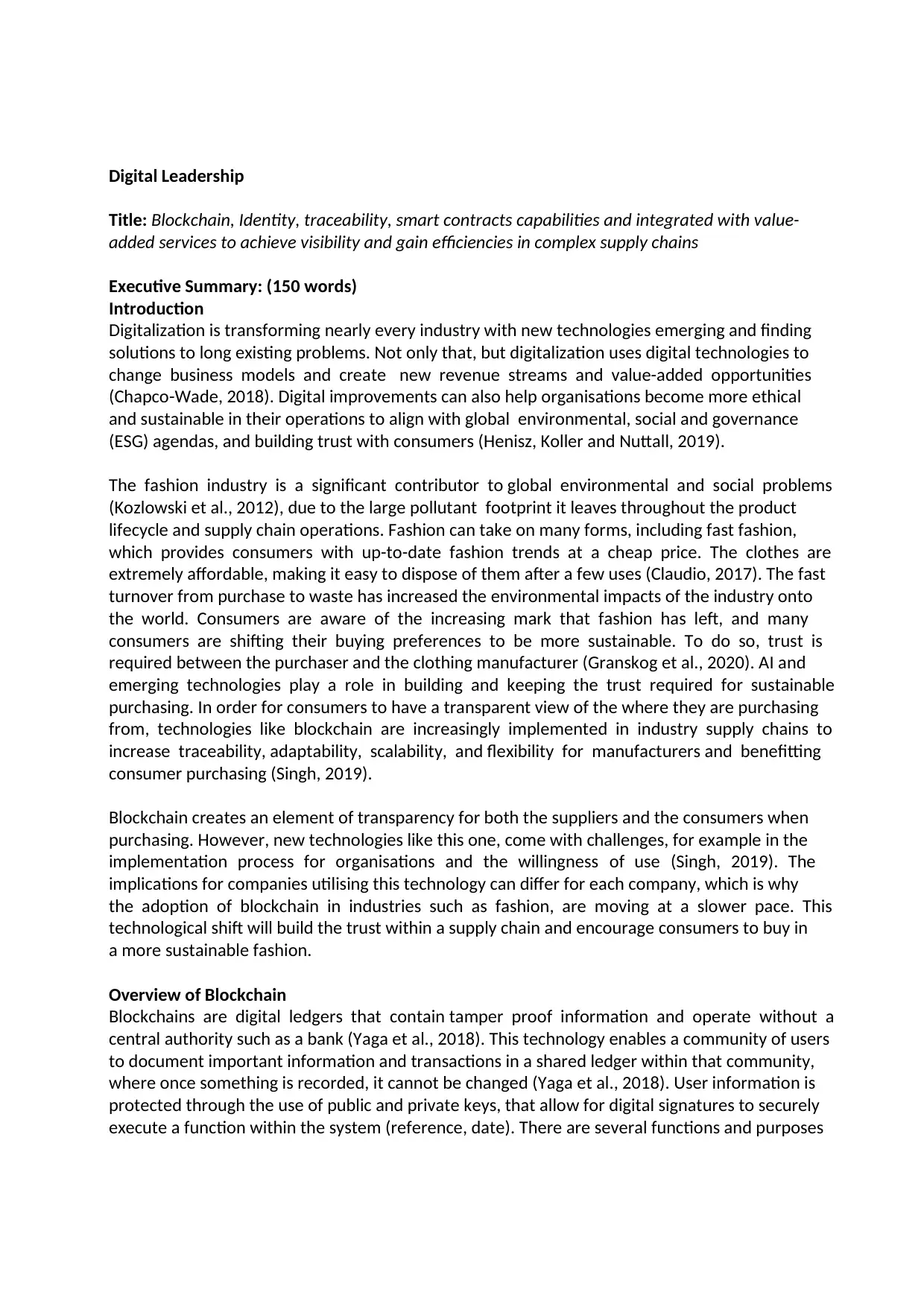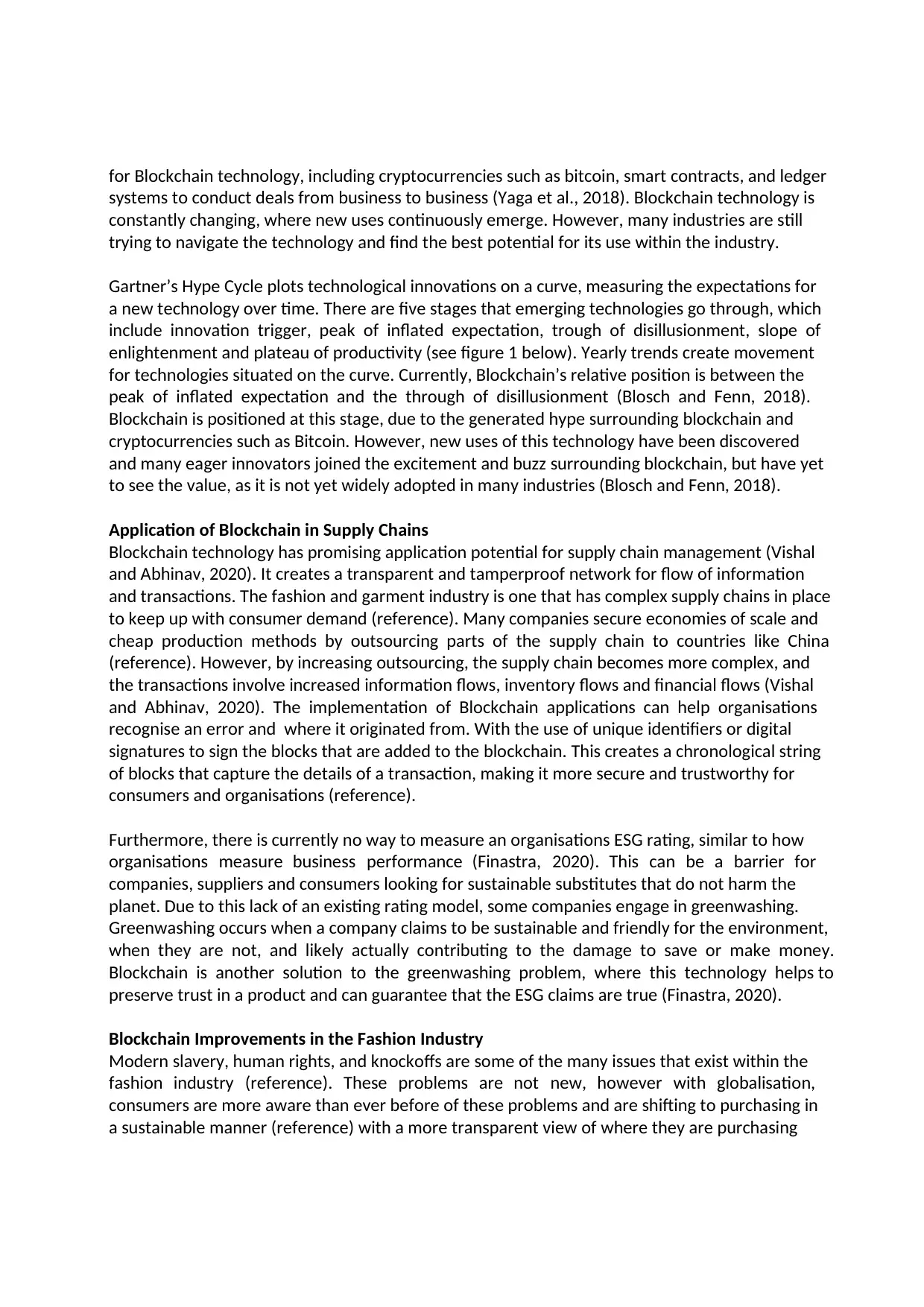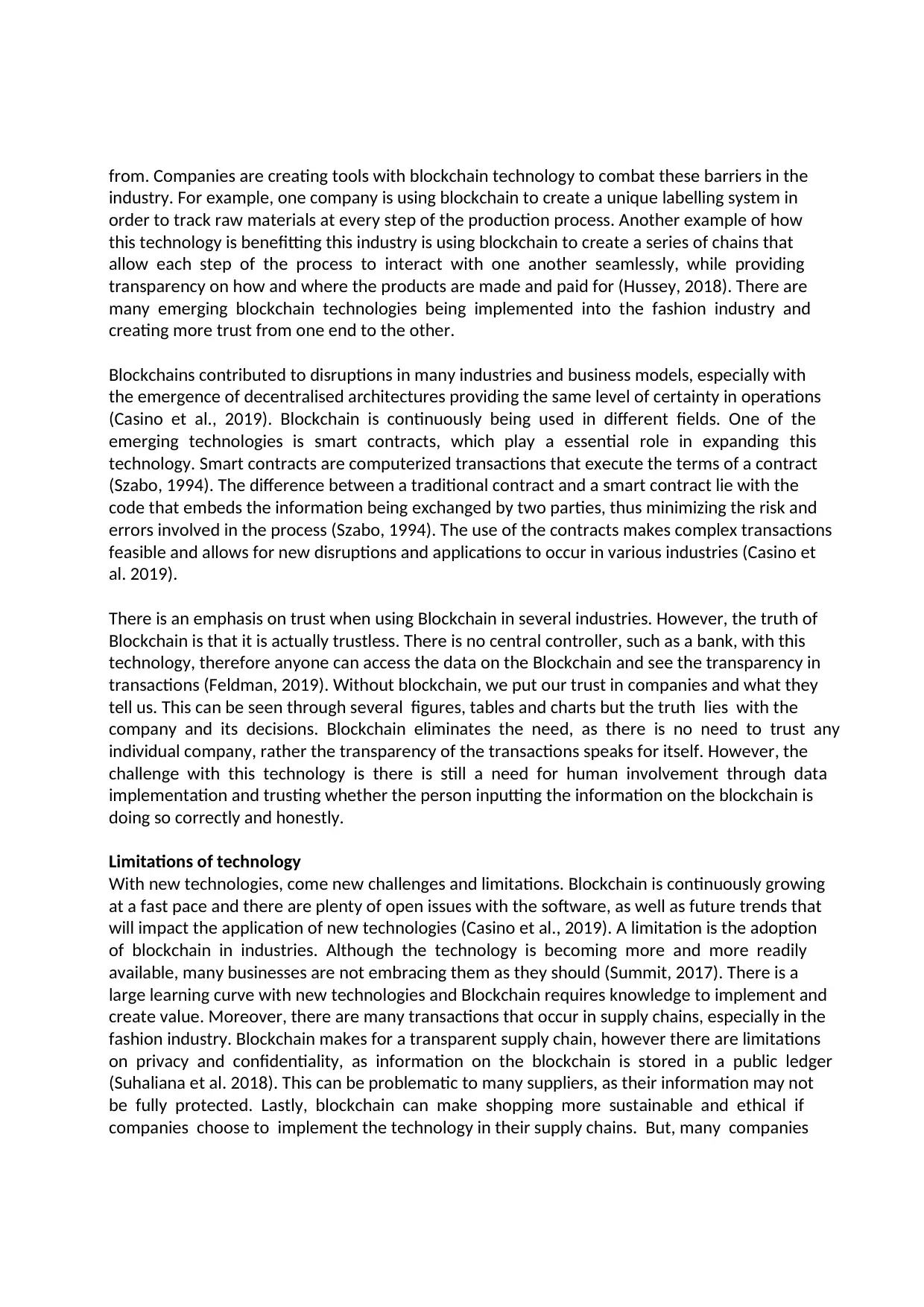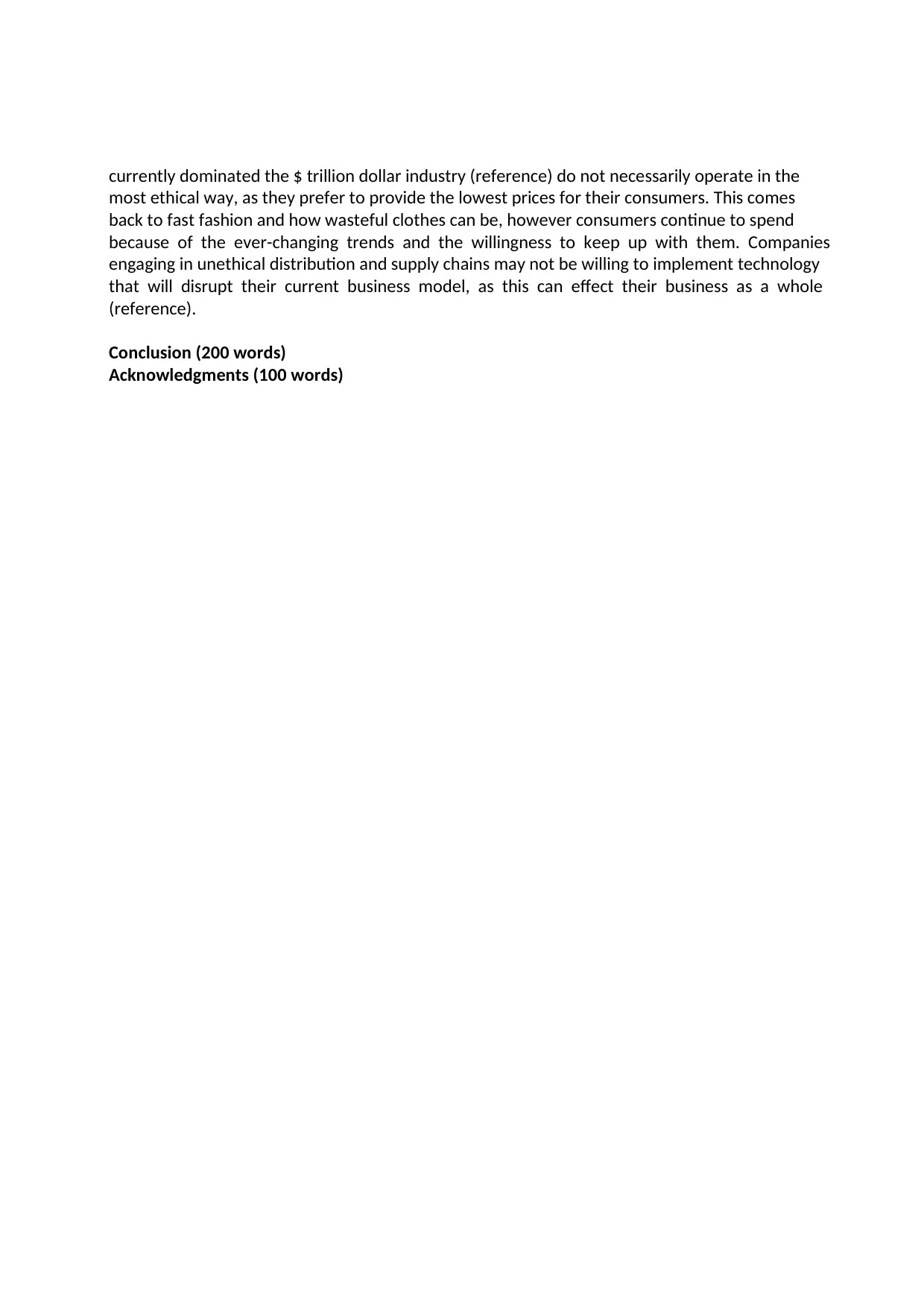(Solved) Digital Leadership - PDF
VerifiedAdded on 2021/06/11
|4
|1921
|34
AI Summary
Contribute Materials
Your contribution can guide someone’s learning journey. Share your
documents today.

Digital Leadership
Title: Blockchain, Identity, traceability, smart contracts capabilities and integrated with value-
added services to achieve visibility and gain efficiencies in complex supply chains
Executive Summary: (150 words)
Introduction
Digitalization is transforming nearly every industry with new technologies emerging and finding
solutions to long existing problems. Not only that, but digitalization uses digital technologies to
change business models and create new revenue streams and value-added opportunities
(Chapco-Wade, 2018). Digital improvements can also help organisations become more ethical
and sustainable in their operations to align with global environmental, social and governance
(ESG) agendas, and building trust with consumers (Henisz, Koller and Nuttall, 2019).
The fashion industry is a significant contributor to global environmental and social problems
(Kozlowski et al., 2012), due to the large pollutant footprint it leaves throughout the product
lifecycle and supply chain operations. Fashion can take on many forms, including fast fashion,
which provides consumers with up-to-date fashion trends at a cheap price. The clothes are
extremely affordable, making it easy to dispose of them after a few uses (Claudio, 2017). The fast
turnover from purchase to waste has increased the environmental impacts of the industry onto
the world. Consumers are aware of the increasing mark that fashion has left, and many
consumers are shifting their buying preferences to be more sustainable. To do so, trust is
required between the purchaser and the clothing manufacturer (Granskog et al., 2020). AI and
emerging technologies play a role in building and keeping the trust required for sustainable
purchasing. In order for consumers to have a transparent view of the where they are purchasing
from, technologies like blockchain are increasingly implemented in industry supply chains to
increase traceability, adaptability, scalability, and flexibility for manufacturers and benefitting
consumer purchasing (Singh, 2019).
Blockchain creates an element of transparency for both the suppliers and the consumers when
purchasing. However, new technologies like this one, come with challenges, for example in the
implementation process for organisations and the willingness of use (Singh, 2019). The
implications for companies utilising this technology can differ for each company, which is why
the adoption of blockchain in industries such as fashion, are moving at a slower pace. This
technological shift will build the trust within a supply chain and encourage consumers to buy in
a more sustainable fashion.
Overview of Blockchain
Blockchains are digital ledgers that contain tamper proof information and operate without a
central authority such as a bank (Yaga et al., 2018). This technology enables a community of users
to document important information and transactions in a shared ledger within that community,
where once something is recorded, it cannot be changed (Yaga et al., 2018). User information is
protected through the use of public and private keys, that allow for digital signatures to securely
execute a function within the system (reference, date). There are several functions and purposes
Title: Blockchain, Identity, traceability, smart contracts capabilities and integrated with value-
added services to achieve visibility and gain efficiencies in complex supply chains
Executive Summary: (150 words)
Introduction
Digitalization is transforming nearly every industry with new technologies emerging and finding
solutions to long existing problems. Not only that, but digitalization uses digital technologies to
change business models and create new revenue streams and value-added opportunities
(Chapco-Wade, 2018). Digital improvements can also help organisations become more ethical
and sustainable in their operations to align with global environmental, social and governance
(ESG) agendas, and building trust with consumers (Henisz, Koller and Nuttall, 2019).
The fashion industry is a significant contributor to global environmental and social problems
(Kozlowski et al., 2012), due to the large pollutant footprint it leaves throughout the product
lifecycle and supply chain operations. Fashion can take on many forms, including fast fashion,
which provides consumers with up-to-date fashion trends at a cheap price. The clothes are
extremely affordable, making it easy to dispose of them after a few uses (Claudio, 2017). The fast
turnover from purchase to waste has increased the environmental impacts of the industry onto
the world. Consumers are aware of the increasing mark that fashion has left, and many
consumers are shifting their buying preferences to be more sustainable. To do so, trust is
required between the purchaser and the clothing manufacturer (Granskog et al., 2020). AI and
emerging technologies play a role in building and keeping the trust required for sustainable
purchasing. In order for consumers to have a transparent view of the where they are purchasing
from, technologies like blockchain are increasingly implemented in industry supply chains to
increase traceability, adaptability, scalability, and flexibility for manufacturers and benefitting
consumer purchasing (Singh, 2019).
Blockchain creates an element of transparency for both the suppliers and the consumers when
purchasing. However, new technologies like this one, come with challenges, for example in the
implementation process for organisations and the willingness of use (Singh, 2019). The
implications for companies utilising this technology can differ for each company, which is why
the adoption of blockchain in industries such as fashion, are moving at a slower pace. This
technological shift will build the trust within a supply chain and encourage consumers to buy in
a more sustainable fashion.
Overview of Blockchain
Blockchains are digital ledgers that contain tamper proof information and operate without a
central authority such as a bank (Yaga et al., 2018). This technology enables a community of users
to document important information and transactions in a shared ledger within that community,
where once something is recorded, it cannot be changed (Yaga et al., 2018). User information is
protected through the use of public and private keys, that allow for digital signatures to securely
execute a function within the system (reference, date). There are several functions and purposes
Secure Best Marks with AI Grader
Need help grading? Try our AI Grader for instant feedback on your assignments.

for Blockchain technology, including cryptocurrencies such as bitcoin, smart contracts, and ledger
systems to conduct deals from business to business (Yaga et al., 2018). Blockchain technology is
constantly changing, where new uses continuously emerge. However, many industries are still
trying to navigate the technology and find the best potential for its use within the industry.
Gartner’s Hype Cycle plots technological innovations on a curve, measuring the expectations for
a new technology over time. There are five stages that emerging technologies go through, which
include innovation trigger, peak of inflated expectation, trough of disillusionment, slope of
enlightenment and plateau of productivity (see figure 1 below). Yearly trends create movement
for technologies situated on the curve. Currently, Blockchain’s relative position is between the
peak of inflated expectation and the through of disillusionment (Blosch and Fenn, 2018).
Blockchain is positioned at this stage, due to the generated hype surrounding blockchain and
cryptocurrencies such as Bitcoin. However, new uses of this technology have been discovered
and many eager innovators joined the excitement and buzz surrounding blockchain, but have yet
to see the value, as it is not yet widely adopted in many industries (Blosch and Fenn, 2018).
Application of Blockchain in Supply Chains
Blockchain technology has promising application potential for supply chain management (Vishal
and Abhinav, 2020). It creates a transparent and tamperproof network for flow of information
and transactions. The fashion and garment industry is one that has complex supply chains in place
to keep up with consumer demand (reference). Many companies secure economies of scale and
cheap production methods by outsourcing parts of the supply chain to countries like China
(reference). However, by increasing outsourcing, the supply chain becomes more complex, and
the transactions involve increased information flows, inventory flows and financial flows (Vishal
and Abhinav, 2020). The implementation of Blockchain applications can help organisations
recognise an error and where it originated from. With the use of unique identifiers or digital
signatures to sign the blocks that are added to the blockchain. This creates a chronological string
of blocks that capture the details of a transaction, making it more secure and trustworthy for
consumers and organisations (reference).
Furthermore, there is currently no way to measure an organisations ESG rating, similar to how
organisations measure business performance (Finastra, 2020). This can be a barrier for
companies, suppliers and consumers looking for sustainable substitutes that do not harm the
planet. Due to this lack of an existing rating model, some companies engage in greenwashing.
Greenwashing occurs when a company claims to be sustainable and friendly for the environment,
when they are not, and likely actually contributing to the damage to save or make money.
Blockchain is another solution to the greenwashing problem, where this technology helps to
preserve trust in a product and can guarantee that the ESG claims are true (Finastra, 2020).
Blockchain Improvements in the Fashion Industry
Modern slavery, human rights, and knockoffs are some of the many issues that exist within the
fashion industry (reference). These problems are not new, however with globalisation,
consumers are more aware than ever before of these problems and are shifting to purchasing in
a sustainable manner (reference) with a more transparent view of where they are purchasing
systems to conduct deals from business to business (Yaga et al., 2018). Blockchain technology is
constantly changing, where new uses continuously emerge. However, many industries are still
trying to navigate the technology and find the best potential for its use within the industry.
Gartner’s Hype Cycle plots technological innovations on a curve, measuring the expectations for
a new technology over time. There are five stages that emerging technologies go through, which
include innovation trigger, peak of inflated expectation, trough of disillusionment, slope of
enlightenment and plateau of productivity (see figure 1 below). Yearly trends create movement
for technologies situated on the curve. Currently, Blockchain’s relative position is between the
peak of inflated expectation and the through of disillusionment (Blosch and Fenn, 2018).
Blockchain is positioned at this stage, due to the generated hype surrounding blockchain and
cryptocurrencies such as Bitcoin. However, new uses of this technology have been discovered
and many eager innovators joined the excitement and buzz surrounding blockchain, but have yet
to see the value, as it is not yet widely adopted in many industries (Blosch and Fenn, 2018).
Application of Blockchain in Supply Chains
Blockchain technology has promising application potential for supply chain management (Vishal
and Abhinav, 2020). It creates a transparent and tamperproof network for flow of information
and transactions. The fashion and garment industry is one that has complex supply chains in place
to keep up with consumer demand (reference). Many companies secure economies of scale and
cheap production methods by outsourcing parts of the supply chain to countries like China
(reference). However, by increasing outsourcing, the supply chain becomes more complex, and
the transactions involve increased information flows, inventory flows and financial flows (Vishal
and Abhinav, 2020). The implementation of Blockchain applications can help organisations
recognise an error and where it originated from. With the use of unique identifiers or digital
signatures to sign the blocks that are added to the blockchain. This creates a chronological string
of blocks that capture the details of a transaction, making it more secure and trustworthy for
consumers and organisations (reference).
Furthermore, there is currently no way to measure an organisations ESG rating, similar to how
organisations measure business performance (Finastra, 2020). This can be a barrier for
companies, suppliers and consumers looking for sustainable substitutes that do not harm the
planet. Due to this lack of an existing rating model, some companies engage in greenwashing.
Greenwashing occurs when a company claims to be sustainable and friendly for the environment,
when they are not, and likely actually contributing to the damage to save or make money.
Blockchain is another solution to the greenwashing problem, where this technology helps to
preserve trust in a product and can guarantee that the ESG claims are true (Finastra, 2020).
Blockchain Improvements in the Fashion Industry
Modern slavery, human rights, and knockoffs are some of the many issues that exist within the
fashion industry (reference). These problems are not new, however with globalisation,
consumers are more aware than ever before of these problems and are shifting to purchasing in
a sustainable manner (reference) with a more transparent view of where they are purchasing

from. Companies are creating tools with blockchain technology to combat these barriers in the
industry. For example, one company is using blockchain to create a unique labelling system in
order to track raw materials at every step of the production process. Another example of how
this technology is benefitting this industry is using blockchain to create a series of chains that
allow each step of the process to interact with one another seamlessly, while providing
transparency on how and where the products are made and paid for (Hussey, 2018). There are
many emerging blockchain technologies being implemented into the fashion industry and
creating more trust from one end to the other.
Blockchains contributed to disruptions in many industries and business models, especially with
the emergence of decentralised architectures providing the same level of certainty in operations
(Casino et al., 2019). Blockchain is continuously being used in different fields. One of the
emerging technologies is smart contracts, which play a essential role in expanding this
technology. Smart contracts are computerized transactions that execute the terms of a contract
(Szabo, 1994). The difference between a traditional contract and a smart contract lie with the
code that embeds the information being exchanged by two parties, thus minimizing the risk and
errors involved in the process (Szabo, 1994). The use of the contracts makes complex transactions
feasible and allows for new disruptions and applications to occur in various industries (Casino et
al. 2019).
There is an emphasis on trust when using Blockchain in several industries. However, the truth of
Blockchain is that it is actually trustless. There is no central controller, such as a bank, with this
technology, therefore anyone can access the data on the Blockchain and see the transparency in
transactions (Feldman, 2019). Without blockchain, we put our trust in companies and what they
tell us. This can be seen through several figures, tables and charts but the truth lies with the
company and its decisions. Blockchain eliminates the need, as there is no need to trust any
individual company, rather the transparency of the transactions speaks for itself. However, the
challenge with this technology is there is still a need for human involvement through data
implementation and trusting whether the person inputting the information on the blockchain is
doing so correctly and honestly.
Limitations of technology
With new technologies, come new challenges and limitations. Blockchain is continuously growing
at a fast pace and there are plenty of open issues with the software, as well as future trends that
will impact the application of new technologies (Casino et al., 2019). A limitation is the adoption
of blockchain in industries. Although the technology is becoming more and more readily
available, many businesses are not embracing them as they should (Summit, 2017). There is a
large learning curve with new technologies and Blockchain requires knowledge to implement and
create value. Moreover, there are many transactions that occur in supply chains, especially in the
fashion industry. Blockchain makes for a transparent supply chain, however there are limitations
on privacy and confidentiality, as information on the blockchain is stored in a public ledger
(Suhaliana et al. 2018). This can be problematic to many suppliers, as their information may not
be fully protected. Lastly, blockchain can make shopping more sustainable and ethical if
companies choose to implement the technology in their supply chains. But, many companies
industry. For example, one company is using blockchain to create a unique labelling system in
order to track raw materials at every step of the production process. Another example of how
this technology is benefitting this industry is using blockchain to create a series of chains that
allow each step of the process to interact with one another seamlessly, while providing
transparency on how and where the products are made and paid for (Hussey, 2018). There are
many emerging blockchain technologies being implemented into the fashion industry and
creating more trust from one end to the other.
Blockchains contributed to disruptions in many industries and business models, especially with
the emergence of decentralised architectures providing the same level of certainty in operations
(Casino et al., 2019). Blockchain is continuously being used in different fields. One of the
emerging technologies is smart contracts, which play a essential role in expanding this
technology. Smart contracts are computerized transactions that execute the terms of a contract
(Szabo, 1994). The difference between a traditional contract and a smart contract lie with the
code that embeds the information being exchanged by two parties, thus minimizing the risk and
errors involved in the process (Szabo, 1994). The use of the contracts makes complex transactions
feasible and allows for new disruptions and applications to occur in various industries (Casino et
al. 2019).
There is an emphasis on trust when using Blockchain in several industries. However, the truth of
Blockchain is that it is actually trustless. There is no central controller, such as a bank, with this
technology, therefore anyone can access the data on the Blockchain and see the transparency in
transactions (Feldman, 2019). Without blockchain, we put our trust in companies and what they
tell us. This can be seen through several figures, tables and charts but the truth lies with the
company and its decisions. Blockchain eliminates the need, as there is no need to trust any
individual company, rather the transparency of the transactions speaks for itself. However, the
challenge with this technology is there is still a need for human involvement through data
implementation and trusting whether the person inputting the information on the blockchain is
doing so correctly and honestly.
Limitations of technology
With new technologies, come new challenges and limitations. Blockchain is continuously growing
at a fast pace and there are plenty of open issues with the software, as well as future trends that
will impact the application of new technologies (Casino et al., 2019). A limitation is the adoption
of blockchain in industries. Although the technology is becoming more and more readily
available, many businesses are not embracing them as they should (Summit, 2017). There is a
large learning curve with new technologies and Blockchain requires knowledge to implement and
create value. Moreover, there are many transactions that occur in supply chains, especially in the
fashion industry. Blockchain makes for a transparent supply chain, however there are limitations
on privacy and confidentiality, as information on the blockchain is stored in a public ledger
(Suhaliana et al. 2018). This can be problematic to many suppliers, as their information may not
be fully protected. Lastly, blockchain can make shopping more sustainable and ethical if
companies choose to implement the technology in their supply chains. But, many companies

currently dominated the $ trillion dollar industry (reference) do not necessarily operate in the
most ethical way, as they prefer to provide the lowest prices for their consumers. This comes
back to fast fashion and how wasteful clothes can be, however consumers continue to spend
because of the ever-changing trends and the willingness to keep up with them. Companies
engaging in unethical distribution and supply chains may not be willing to implement technology
that will disrupt their current business model, as this can effect their business as a whole
(reference).
Conclusion (200 words)
Acknowledgments (100 words)
most ethical way, as they prefer to provide the lowest prices for their consumers. This comes
back to fast fashion and how wasteful clothes can be, however consumers continue to spend
because of the ever-changing trends and the willingness to keep up with them. Companies
engaging in unethical distribution and supply chains may not be willing to implement technology
that will disrupt their current business model, as this can effect their business as a whole
(reference).
Conclusion (200 words)
Acknowledgments (100 words)
1 out of 4
Related Documents
Your All-in-One AI-Powered Toolkit for Academic Success.
+13062052269
info@desklib.com
Available 24*7 on WhatsApp / Email
![[object Object]](/_next/static/media/star-bottom.7253800d.svg)
Unlock your academic potential
© 2024 | Zucol Services PVT LTD | All rights reserved.





